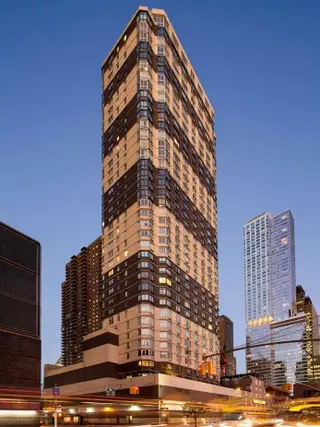 Carter Horsley
Carter HorsleyDec 23, 2011
Carter's Review
In the Art Deco period, it was not unusual to "band" a building with horizontal stripes.
Such banding, however, usually was rather subtle with closely related colors and a repetitive regularity to spacing between the bands.
This 41-story rental apartment building has very prounced and irregular banding and is not trying to recall the Art Deco period.
Hugh Hardy of Hardy Holtzman Pfeiffer Architects designed the building and in an October 21, 2001 article in The New York Times by Tracie Rozhon, maintained that the building "is intended to be a building of special character - I don't want to say legendary character. But the Chrysler Building is at the other end of the street, and the patterning and decoration here is meant to have its own pizazz, and reflect the energy of 42nd Street."
The article said that Mr. Hardy "is not bothered by what he describes as neighborhood criticism of his building, which has been nicknamed 'the zebra.'"
The building was developed by The Brodsky Organization and Quinlan & Field and the article quoted Daniel Brodsky as stating that "it's not your traditional building that's meant to blend into the surroundings," adding that "Hugh Hardy felt - and we agree - that you build contextual buildings in a place where there is context. Here, there is 42nd Street."
Mr. Brodsky is one of the city's most active residential developers, especially in the area north of this Clinton neighborhood, and Mr. Hardy is one of the city's most revered preservationists.
When this tower was completed, West 42nd Street had only a few residential towers. That skyline, however, has changed dramatically with the addition of several more major towers and projects. The newer towers have not helped the contextual issue, although they have tended to use more glass and tended towards a blue palette.
The notion of having bands of different and graduated heights is interesting, in theory, especially since the most famous tower on West 42nd Street for decades had been Raymond Hood's famous "Green Giant," the former McGraw-Hill tower with its horizontal banding.
The effect here would probably have been better if the colors were not very light cream and purplish black. Shades of green or blue or gray or yellow or red might have worked better. The good news, however, is that all the new construction has crowded the tower's isolation and made its distinctive "patterning" less noticeable.
Ms. Rozhon's article quoted Mr. Hardy as stating that a neighbor said it "looked like the architect had spilled cappuccino over the plans, and it got built by mistake."
The first three floors of the tower contain a 499-sear Off Broadway theater and Playwrights Horizons built a theater complex next door at 416 West 42nd Street, some of whose air rights were used for this tower and the developers of this tower reconstructed five more nearby theaters.
The tower's massing is modulated not only by the façade banding but also by its widespread use of bay and corner windows. The upper portion of the tower cantilevers out a little ways in the middle of the longer sides of the slab.
The building has a concierge, a fitness center, a roof deck, a bicycle room, an ATM and is pet-friendly.

- Rental built in 2001
- 1 apartment currently for rent ($4.2K)
- Located in Midtown West
- 264 total apartments 264 total apartments
- Doorman
- Pets Allowed
 6sqft delivers the latest on real estate, architecture, and design, straight from New York City.
6sqft delivers the latest on real estate, architecture, and design, straight from New York City.
